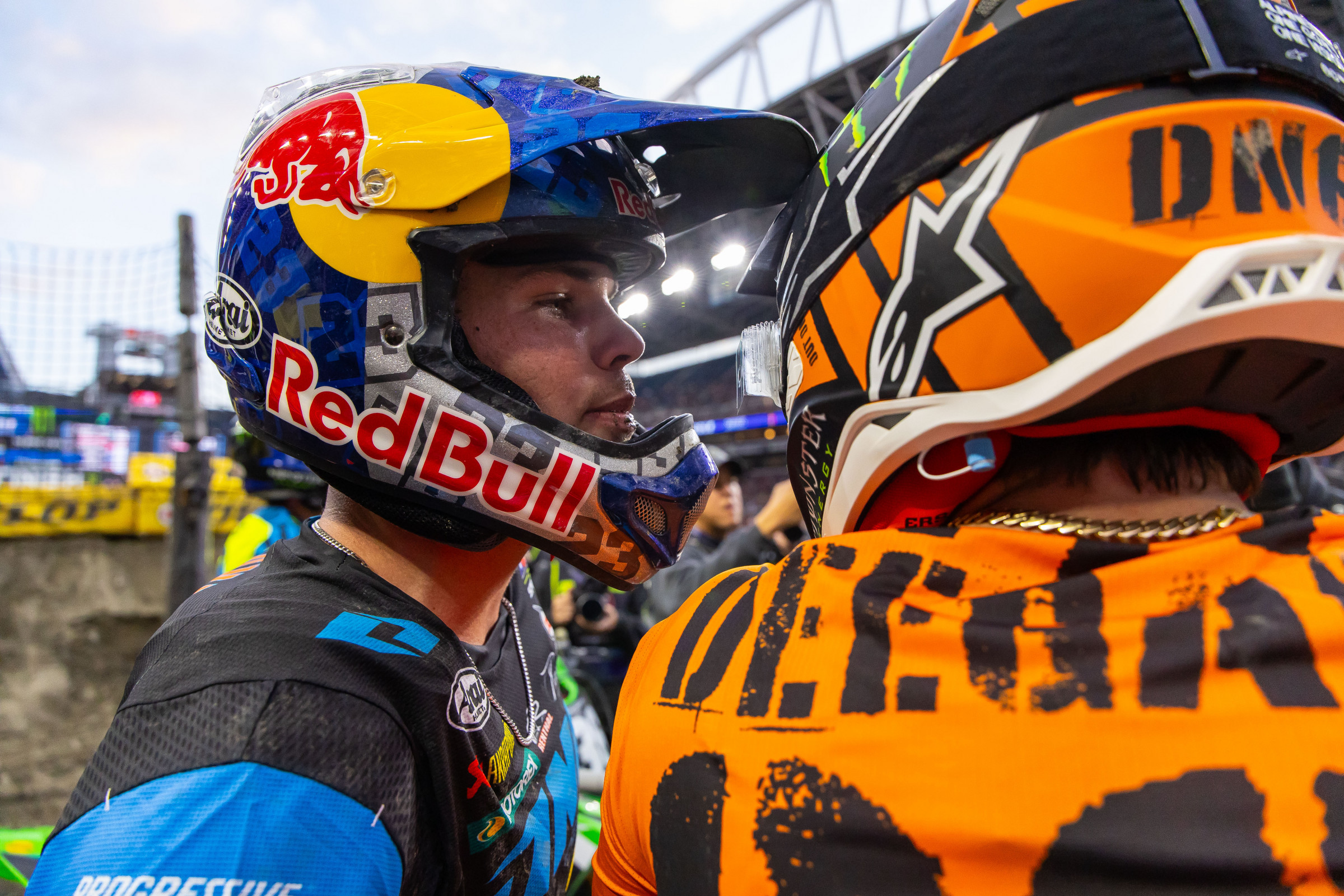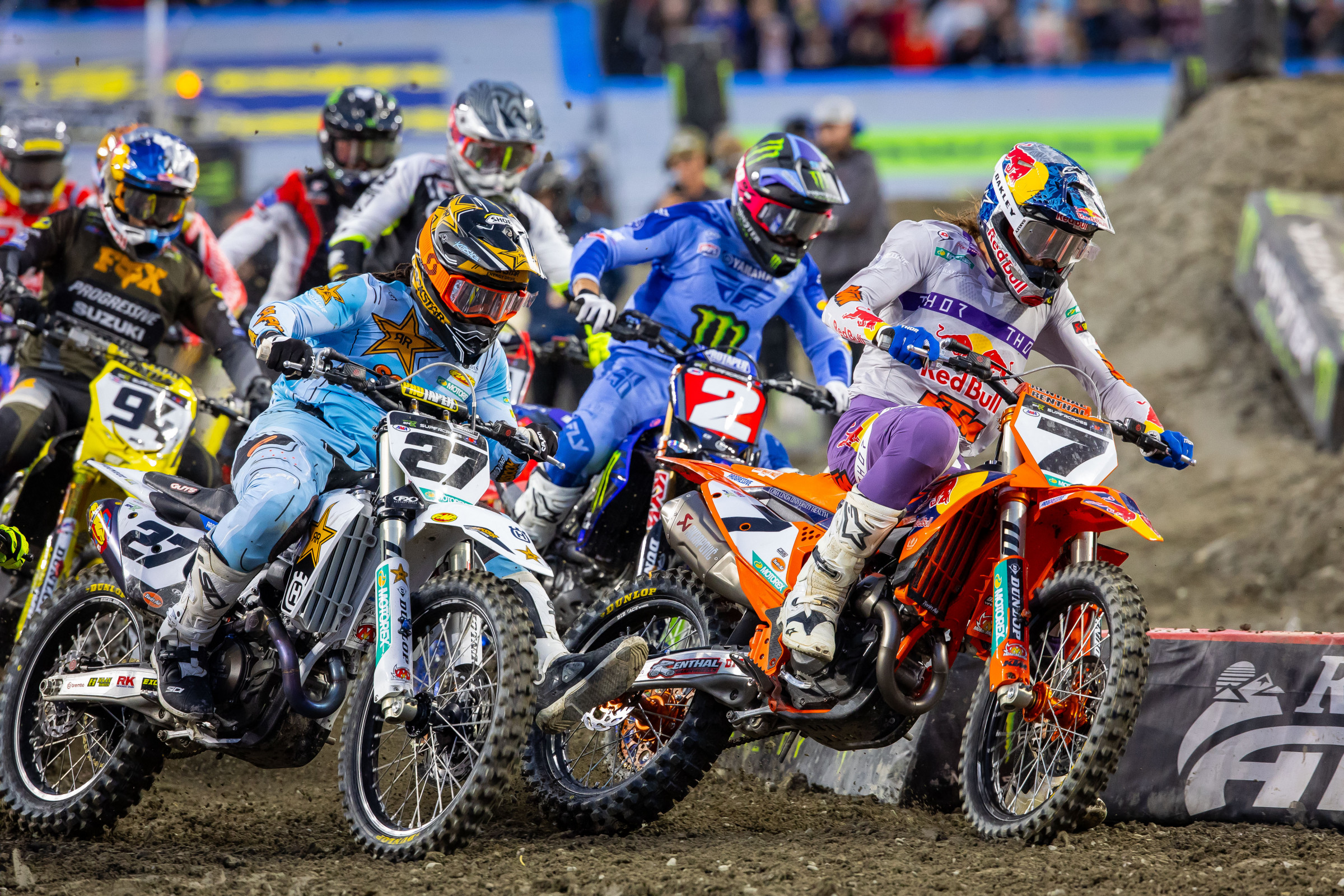Monster Energy AMA Supercross was in Seattle over the weekend, where the riders competed on an extremely difficult and technical track that rewarded some, and punished others. As usual, the action left us with plenty of questions, which we sent to former pro and NBC reporter Jason Thomas.
We dodged a rainy bullet in Seattle, with the weather clearing up for race day. The track still got pretty tough and rutty though. What sort of difficulty did the conditions present to the riders on Saturday night?
The series did catch a break with Saturday’s weather. The rains on Friday left a soggy racetrack, though. The conditions were technical and difficult, but better than 2024. It was in this tricky middle ground where riders needed to put big rhythms together but they became more and more difficult to execute as the laps wore on. This can lead to big crashes as riders continue to try to pull off triples and bigger options. It was a thinking man’s racetrack versus the, “turn your brain off and turn the throttle on” type tracks we see in January.
There were a few spots on the track that developed what looked like braking bumps or something you’d see at a national. Namely by the mechanic’s area and the righthand sweeper after the long rhythm lane. Have you ever seen it get like that in supercross before? What causes bumps like that to develop?
Yes, this is a normal dynamic for soft racetracks. The dirt is soft and wet, which makes it dynamic. The dirt will move with the forces applied to it by braking and acceleration. What makes those bumps form in motocross? The dirt is softer and more supple. The same rules applied for the Seattle track. The dirt was forming just like a motocross track would. Most SX tracks have a very hard base which stays relatively static during the race. Seattle was soft enough to change before our eyes.
Justin Cooper passed Cooper Webb around the outside in a righthand sweeper in the heat race and went on to win. If Cooper tried that move in a main event, would Webb have allowed it, or would he have shut the door? Why didn’t he block Cooper there?
It looked like Webb was struggling a bit in the heat race. I don’t think he could hold J-Coop off, and making a block there was likely delaying the inevitable. Further, I think there’s a chance he wanted to see where J-Coop was going so he could learn his lines. If you noticed, Webb closed the lead back down on the last lap or two, which was an indicator that he was figuring things out. In the main event, he may have been more forceful with a block but that would be situational to Chase Sexton’s position, too. An experienced rider like Webb would likely be assessing the situation around him and then determining how much risk to employ. That track was so easy to make a big mistake on that riders couldn’t just throw caution out the window. Every raise in the risk ratio had to be accounted for or you were destined for a soil sample.
Speaking of Cooper, he had an excellent night going until he crashed in a rhythm lane while running third. Did you see the crash? If so, what was the catalyst?
J-Coop was hugging the edge of the track trying to find fresher lines. That comes with risk though, as any mistake puts you into those Tuff Blocks. He just got off line a tiny bit and the rest was history. It’s a common occurrence to try to use the edges, as few are willing to risk that but the penalty is high. Think Pierce Brown at Tampa—the same rules apply.
At one point in the 450SX main event Sexton had pulled a gap on Webb and looked to have the win in hand. Webb still managed to find a way to get the job done, however. How and where did Webb cut into Sexton’s gap?
Sexton had that rhythm section dialed and was gaining big time there each lap. He missed the middle triple a few times, though, and that helped Webb come back to the fight. Also, Sexton made a mistake or two in the rhythm after the first corner. Webb was a tad bit slower but his consistency gave him a chance late. If Sexton could have avoided those small mistakes in those pivotal laps, he would have finished the deal. It’s not always about how fast you can go, it’s about how fast you can go every single lap without the mistakes that will unwind all of that time gain.
Aaron Plessinger got a monster jump when the gate dropped in the 450SX main, but ended up drifting way wide and giving up multiple spots. What did he do wrong in this situation? Was it simply a matter of holding it on too long?
AP has been nailing the starts. He just pushed a little deep there and when he tried to lean in and turn, the bike stood up on him and pushed wide. That opened the door for Webb to sneak inside, which was his plan, and brake early and control the inside. There’s no signal that says when to let off when barreling toward the first corner. It’s a judgment call for when you will get the holeshot but also can brake to make the turn. AP missed it by about five feet.
Note: Plessinger said in the post-race press conference he stalled his bike, which caused him to go wide.
Jo Shimoda ran it in hard on Haiden Deegan a couple times in the 250SX main event. Shimoda typically doesn’t make moves like that. Did something happen between the two of them in Seattle to rile Shimoda up?
I’m not aware of any Deegan/Shimoda beef but I would guess that many of the 250 riders don’t care for the antics. Deegs doesn’t pull any punches on or off the track so it’s not shocking to see some riders fire back. I didn’t see anything out of line from Shimoda, but the aggression was certainly notable. I think it’s all a fair play, though, as Deegs would certainly do the same if needed.
Deegan drilled Julien Beaumer pretty hard in the main event. Did he need to hit him that hard to make the pass? What was the motivation for making a move like that?
Haiden was not happy with the leaning in by JuJu on the arrest situation. They have been trading blows in every way imaginable, trying to irk the other. Deegs was looking for a window to levy a shot and found it on the last lap. I don’t think either of them have any interest in squashing it so we will likely see more of this. There are hard feelings here but so be it. No one said these guys have to like each other.
People talk about Beaumer being a west coast rider a lot, and say he’s not great in ruts. Seattle was pretty rutty, what’d you make of his riding?
He looked much better than he did at Indy. Most of that was an improvement in his shoulder but he also rode well in the conditions. It’s not that I think he “can’t” ride softer conditions, I just believe his strength over most is his skill on harder dirt. He has a distinct edge on harder dirt, not so much on the softer, ruttier stuff. It doesn’t have to be a liability but I don’t believe it’s his strength. He’s one of the main guys in all conditions but when traction is scarce, he is elite.
Jordon Smith crashed approximately 783 times in Seattle. To be fair, they weren’t all his fault, but some of them were. Was this a product of him trying to come back too early after injury? Was it just one of those nights?
Smith is a rider that takes a lot of risk. He has always been this type. Sometimes it works and the payoff is huge. Other times, like Saturday, he pays the price many times over. I don’t believe that Seattle was a track that rewarded taking risk. Caution can be the better part of valor. Riding within the limit may not feel like the best pathway but it can pay off as chaos reigns around you. I am not sure if Smith will ever change, it seems unlikely at this point. He’s a high risk/high reward racer. The other factor is that he had ridden once or twice before Seattle. He was rusty and not 100% healthy. Pushing the edge while a bit off your game makes the ask even tougher. He was surely excited to get back out there and this could be a situation where he was simply trying too hard.










